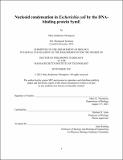| dc.contributor.advisor | Laub, Michael T. | |
| dc.contributor.author | Thompson, Mary Katherine | |
| dc.date.accessioned | 2022-05-24T19:20:23Z | |
| dc.date.available | 2022-05-24T19:20:23Z | |
| dc.date.issued | 2021-09 | |
| dc.date.submitted | 2022-05-19T17:58:19.401Z | |
| dc.identifier.uri | https://hdl.handle.net/1721.1/142706 | |
| dc.description.abstract | Bacteria are at the mercy of whatever environment surrounds them. As such, they have developed a number of clever methods to respond to the myriad of stressors that they face. Toxin-antitoxin (TA) systems are one of the most interesting yet poorly understood of these methods. TA systems are genetic modules made up of a toxin that can kill a cell or stop its growth and an antitoxin that counteracts its cognate toxin. Type I TA systems consist of a toxic protein and an RNA antitoxin which interacts directly with toxin mRNA to prevent its translation. The toxins of all but two type I TA systems are small proteins that imbed into the inner membrane where they generally oligomerize and form pores that effect membrane permeability and proton gradient formation. symE/symR from Escherichia coli is characterized as a type I TA system with a non-canonical toxin. Rather than forming inner membrane pores, SymE is believed to be an endoribonuclease that has predicted structural similarity to DNA binding proteins. In this work I sought to better understand SymE’s target preference and specificity. Surprisingly, when I assessed the transcriptome for RNA cleavage events after symE expression Isaw no evidence of RNase activity. Instead I show that SymE binds DNA both in vitro and in vivo. Furthermore, I demonstrate that the toxicity of symE overexpression is likely due to its accumulation in the nucleoid and subsequent severe nucleoid condensation. This condensation is accompanied by DNA damage. Nucleoid compaction, DNA damage and global downshifts in transcription and translation are consistent with lethal levels of the E. coli nucleoid associated protein H-NS. Taken together, SymE’s reclassification from RNase to DNA binding protein, and its toxicity only being evident at high expression, has thrown into question symE/symR’s classification as a type I TA system. | |
| dc.publisher | Massachusetts Institute of Technology | |
| dc.rights | In Copyright - Educational Use Permitted | |
| dc.rights | Copyright retained by author(s) | |
| dc.rights.uri | https://rightsstatements.org/page/InC-EDU/1.0/ | |
| dc.title | Nucleoid condensation in Escherichia coli by the DNAbinding protein SymE | |
| dc.type | Thesis | |
| dc.description.degree | Ph.D. | |
| dc.contributor.department | Massachusetts Institute of Technology. Department of Biology | |
| mit.thesis.degree | Doctoral | |
| thesis.degree.name | Doctor of Philosophy | |
